
The Mexican peso is the currency of Mexico. Modern peso and dollar currencies have a common origin in the 16th–19th century Spanish dollar, most continuing to use its sign, "$".
The peso is the currency of Chile. The current peso has circulated since 1975, with a previous version circulating between 1817 and 1960. Its symbol is defined as a letter S with either one or two vertical bars superimposed prefixing the amount, $ or ; the single-bar symbol, available in most modern text systems, is almost always used. Both of these symbols are used by many currencies, most notably the United States dollar, and may be ambiguous without clarification, such as CLP$ or US$. The ISO 4217 code for the present peso is CLP. It was officially subdivided into 100 centavos, until the subdivision was eliminated in 1984 due to its low value. The exchange rate was around CLP$730 to 1 United States dollar as of March 2021.
The quetzal is the currency of Guatemala, named after the national bird of Guatemala, the resplendent quetzal. In ancient Mayan culture, the quetzal bird's tail feathers were used as currency. It is divided into 100 centavos, or len in Guatemalan slang. The plural is quetzales.

The córdoba is the currency of Nicaragua. It is divided into 100 centavos.
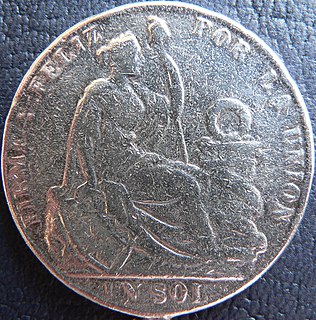
The sol, later sol de oro, was the currency of Peru between 1863 and 1985. It had the ISO 4217 currency code PES. It was subdivided into 10 dineros or 100 centavos. It also had two different superunits over its circulation life, the inca (1881-1882) and later the gold pound, both worth 10 soles.
The Colombian peso is the currency of Colombia. Its ISO 4217 code is COP. The official peso symbol is $, with Col$. also being used to distinguish it from other peso- and dollar-denominated currencies.

The cruzado was the currency of Brazil from 1986 to 1989. It replaced the second cruzeiro in 1986, at a rate of 1 cruzado = 1000 cruzeiros (novos) and was replaced in 1989 by the cruzado novo at a rate of 1000 cruzados = 1 cruzado novo.
Peso dominicano has been the name of the currency of the Dominican Republic since 2011. Its symbol is "$", with "RD$" used when distinction from other pesos is required; its ISO 4217 code is "DOP". Each peso is divided into 100 centavos ("cents"), for which the ¢ symbol is used. With exception of the United States dollar, it is the only currency that is legal tender in the Dominican Republic for all monetary transactions, whether public or private.
The boliviano is the currency of Bolivia. It is divided into 100 cents or centavos in Spanish. Boliviano was also the name of the currency of Bolivia between 1864 and 1963. From April 2018, the manager of the Central Bank of Bolivia, Pablo Ramos, announced the introduction of the new family of banknotes of the Plurinational State of Bolivia, started with the 10 Bs note, and then gradually arrived to introduce the 200 Bs note, presented in April 2019. The new family of banknotes of the Plurinational State received several awards such as "the best banknotes in Latin America", was highlighted by its security measures, its aesthetics and its inclusion of prominent figures in Bolivian history, being among those who awarded the "Latin American High Security Printing Press Conference".
The colón was the currency of El Salvador from 1892 until 2001, when it was replaced by the U.S. dollar during the presidency of Francisco Flores. The colón was subdivided into 100 centavos and its ISO 4217 code was SVC. The plural is "colones" in Spanish and the currency was named after Christopher Columbus, known as Cristóbal Colón in Spanish.

The inti was the currency of Peru between 1985 and 1991. Its ISO 4217 code was PEI and its abbreviation was I/. The inti was divided into 100 céntimos. The inti replaced the inflation-stricken sol. The new currency was named after Inti, the Inca sun god.

The escudo was the currency of São Tomé and Príncipe between 1914 and 1977. It was equivalent to the Portuguese escudo and subdivided into 100 centavos.

The peso was a currency of Ecuador until 1884.
The sol is the currency of Peru; it is subdivided into 100 céntimos ("cents"). The ISO 4217 currency code is PEN.

The real was the currency of Peru until 1863. Sixteen silver reales equalled one gold escudo. The silver coin of 8 reales was also known as the peso.
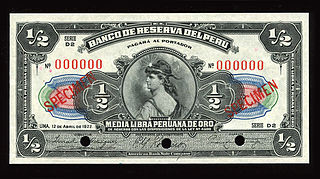
The Peruvian gold pound, was a unit of currency issued in Peru between 1898 and 1931. It was fixed in value to 10 soles and was issued in the form of gold coins and banknotes, which circulated alongside coins denominated in centavos, dineros and soles. The gold pound was equal to the British sovereign.

The Cruzado Novo was the short-lived currency of Brazil between 15 January 1989 and 15 March 1990. It replaced the cruzado in the rate of 1000 cruzados = 1 cruzado novo. It had the symbol and the ISO 4217 code BRN. In 1990, the cruzado novo was renamed the (third) cruzeiro. This currency was subdivided in 100 centavos.
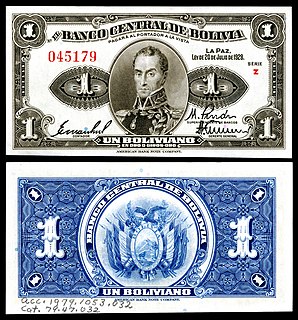
The first boliviano was the currency of Bolivia from 1864 to 1963. Due to rising inflation, it was replaced with the peso boliviano at an exchange rate of 1000 bolivianos to 1 peso. The peso was later replaced by the second Bolivian boliviano.
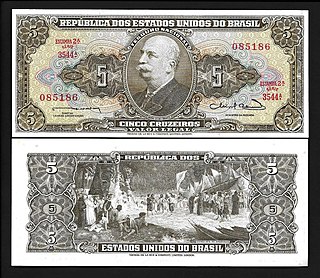
The (first) cruzeiro (Cr$) was the official currency of Brazil from 1942 to 1967. It replaced the old real, which had been in use since colonial times, at the rate of Rs 1$000 = Cr$1, It was in turn replaced by the cruzeiro novo, at the rate of Cr$1,000 = NCr$1.
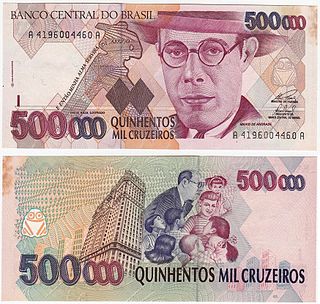
The cruzeiro was the currency of Brazil between 1990 and 1993. It was the third iteration of a Brazilian currency named "cruzeiro", and replaced the cruzado novo at par. It was used until 1993, when it was replaced by the cruzeiro real at a rate of 1 cruzeiro real = 1000 cruzeiros.












